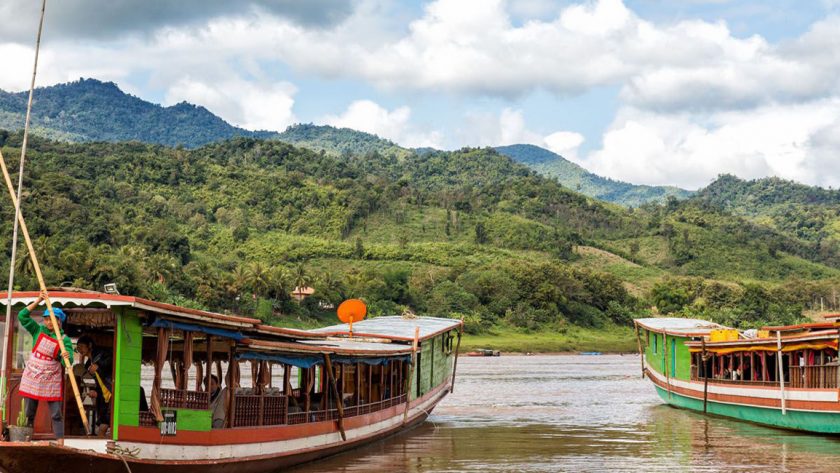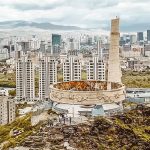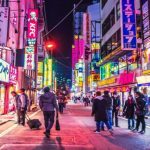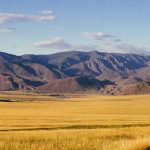A group of saffron robed monks walking down the dirt road seemed to melt into the large, fiery sun setting over the capital of Vientiane. The dust from their tracks hung in the humid air for a moment, then settled, and the city resumed its quiet slumber. I fanned myself, and felt no great need to move, simply to bask in the dying embers of the day and give in to the seductiveness of Laos.
I had crossed the Mekong the day before, leaving the 7-11’s of Thailand behind, and immediately knew that though the Lao and Thai languages are similar, their countries seems centuries apart. A handful of 1950’s Russian cars seem anachronistic in the capital city, not because they were 40 years old, but because they seemed too modern for the sleepy capital, where water buffalo still roam the early morning streets, French colonial homes are scattered between gorgeous Buddhist wats, and the rice fields are a short bicycle ride from the city center.
And, though, during the Vietnam War, the United States dropped the equivalent of a bomb on Laos every nine minutes for eight years, every single individual I met showed me unbelievable hospitality and friendliness
In 12 months of continuous backpacking through Asia, Laos was one of the places that I truly fell in love with. It is, however, not for the tourist, but for the traveler who can appreciate beauty alongside a few hardships.
Vientiane is the easiest place to visit, and has several beautiful wats over a century old, including Wat Si Saket and Wat Pha Kaew. Pha That Luang, a great golden spire is the symbol of Laos, and appears on their currency, the kip. One of the typically anachronistic features of Laos is the faux Arc de Triomphe in the center of the city , with dozens of small mopeds and clanging bicycles zipping around its traffic circle. Though Laos was part of French Indochine, the French never had a large population in-country, and their lasting effects are most visible in some of the architecture, and perfectly baked baguettes with pate sold every morning on the street corners. Though Laos is a communist country, you’d never know it – the people seem more relaxed than politically charged.
It’s when I began heading north that the adventures (or hardships, depending on your attitude) really began. The infrastructure of Laos is almost nonexistent. It’s actually rather nice when you realize you haven’t a telephone wire strung across your vision ruining your view. Outside of a dozen cities, there is no reliable electricity, very little pavement, and a lot of jungle. I took a 12 hour bus ride along Highway 13, the infamous Robber’s Road, to Luange Prabang. The highway is now paved, a major accomplishment, and a dozen army outposts along the way are security. The views are spectacular, full of karst limestone peaks jutting through rain forest clouds and villages of bamboo huts perched on hillsides.
Luang Prabang is a World Heritage site along the Mekong River with 32 temples, spectacular caves, and a 4 tiered waterfall called Khong Si. A few travelers hostels supply beds, and nature supplies perfection. I spent a perfect afternoon splashing and swimming with bronzed children in the swirling waters of the Mekong, sipping pineapple lassi (yogurt drink) and having a bowl of pho noodles with fresh coffee from the owners of a plantation a few miles out of town. It’s this kind of lifestyle that makes me wonder why one should ever return to Kmart and traffic jams and office cubicles (The correct answer is- one shouldn’t, not for too long)
The Mekong is the major means of transportation in western Laos, and so I chugged up river for five days on all sorts of boats: hulking Conradian barges, bamboo rafts, and souped-up Thai longtail speedboats. Overnighting in villages along the way where there are no hotels, only friendly customs officials and locals who let me share a corner of their floor, bathing in the Mekong at dusk with the entire village, eating the famous sticky rice for dinner under moonlight with families – this was the Laos that few travelers saw. It opened up a country to me that, before now, I knew very little about. And though, during the Vietnam war, the United States dropped the equivalence of a bomb on Laos every nine minutes for eight years, every single individual I met showed me unbelievable hospitality and friendliness.
After nearly a week of exciting, but hard traveling, I was within fifty miles of Chinese border, which I hoped to cross. Unfortunately, no more boats proceeded north, and I was dropped off on a riverbank on the middle of nowhere, and told to follow the sun for two days until I found a village. Needless to say, I was terrified. So, for two days, I walked, and my terror was matched by my awe at the folding hills, the tiny settlements that I came upon, and the incredible hill tribes that fed me and housed me when I came upon them. Hmong, Akha, Liu and other minority people live in this remote area in much the same way as they have for the last several centuries: farming, still wearing the beautiful traditional clothing and practicing animism. It took nine hours to cover about twenty five miles to Boten, the border crossing town for China.
By this time, I was physically exhausted. I paid a special “Sunday border fee” (read:bribe) without much complaint, and hitched a ride in the back of a pick up truck into China, which, in comparison, seemed like the lap of luxury. Of course, that meanly ugly modern buildings, telephone wires, noise, and leaving behind the most pure combination of adventure and serenity that I’ve ever experienced.
Just the Facts for Laos
Visas for Laos are obtainable at all border crossings within Thailand (including Nhong Kai and Huay Xi), as well as various embassies of China, Cambodia, and Vietnam, and in the U.S. They cost approximately $30-75 and are usually good for 15 days for US citizen. Other citizen get different stays and extensions are possible, but depend largely on the personality of the official you happen to be talking to.
With the current economic crisis throughout Asia, you now get more kip for your buck $1 US =1,138 kip. With a lavish meal costing no more than a few thousand kip, this is a sweet deal these days. And the black market rates are even better in Veintiane.
There are plenty of hostels in Vientiane and Luange Prabange and other major sites, but beyond that, rooms are scarce. It’s fairly common to stay with families that offer some space for a few thousand kip if you are in more remote areas.




kamagra pilules soins de santé canadiens
comprar kamagra en usa
how to buy enclomiphene generic drug
enclomiphene without doctor rx
how to order androxal cost australia
how to order androxal generic uk buy
brand flexeril cyclobenzaprine online
cheapest buy flexeril cyclobenzaprine uk london
how to order dutasteride price for prescription
buy cheap dutasteride cheap next day delivery
order gabapentin canada discount
cheapest buy gabapentin generic ingredients
24 meds fildena
purchase fildena usa online pharmacy
buy cheap itraconazole price south africa
cheapest buy itraconazole uk online pharmacy
how to buy avodart purchase online uk
buy avodart usa where to buy
get rifaximin generic buy online
cheapest buy rifaximin new york city
ordering xifaxan canada purchase
buy canadian xifaxan online
nízké náklady kamagra
kamagra recepty